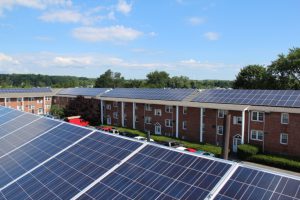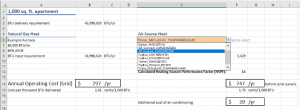How Do Heat Pumps Work and What Makes Them So Great?
| . Posted in News - 3 Comments
By Eric Weld, MassLandlords, Inc.
As heat pumps are becoming a more popular way for heating and cooling homes and buildings in the United States and around the globe, information and details about what they do and how they work is spreading fast, and not always accurately.
For example, it’s often described in some media that air source heat pumps – the most common type for homes – “move air” from outside to inside or vice versa. That is an incorrect explanation. Air source heat pumps circulate refrigerant through the system, which exchanges heat with the system’s surroundings.
As heat pumps enter our daily dialogue and become the standard way in which we heat and cool our homes in the coming years (not decades), we thought this would be a good time to explain how these highly efficient machines work and why they work the way they do.
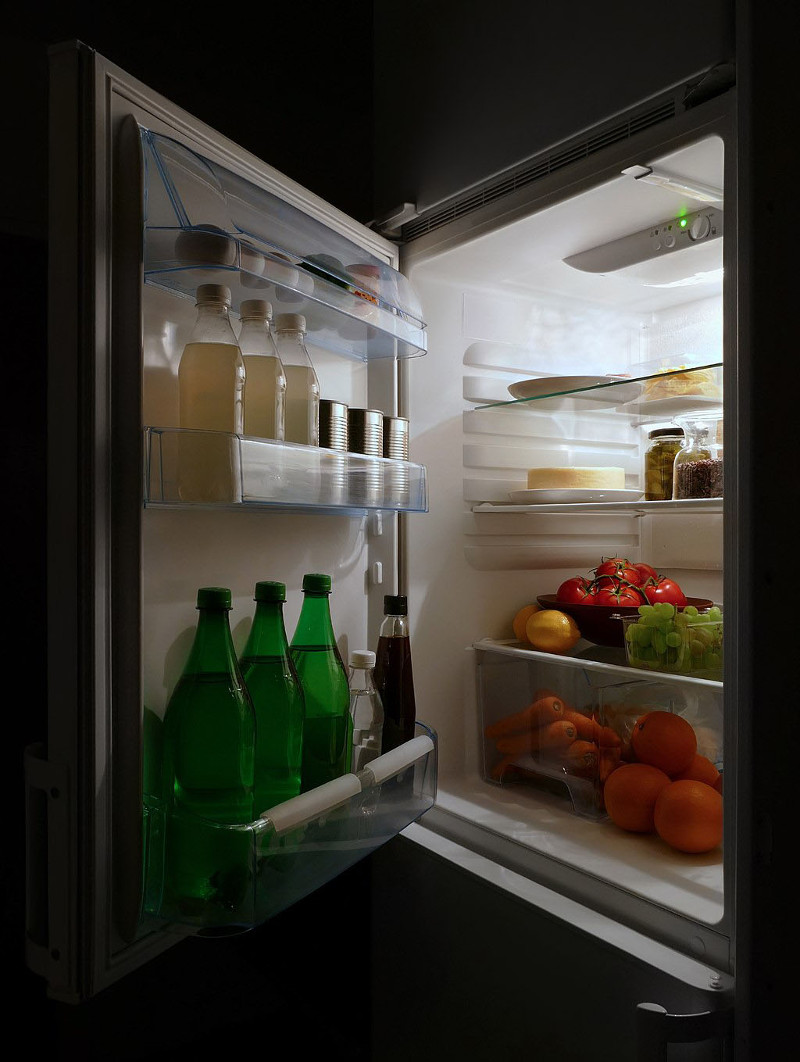
An air source heat pump works exactly the same as a refrigerator. Image: CC-BY-SA-4.0 Wikimedia Commons
A Big Refrigerator
You could say a heat pump is like a big refrigerator (or air conditioner), except instead of cooling a 40- by 72-inch metal box, it’s scaled to cool or heat an entire home or building. In some ways it’s surprising that we’ve taken so long (more than 100 years since the first home refrigerator) to scale that technology to homes and buildings. This delay was likely due to the apparent abundance of cheap fuels, such as coal, followed by oil and natural gas, in the early 20th century.
Very simply, your refrigerator circulates a chemical compound refrigerant in and out of the controlled space via a network of coiled copper pipes and specialized parts like an evaporator and compressor. The refrigerant, in liquid form, absorbs heat from the interior space as it passes through the coils, making the space cooler. The heated refrigerant changes from liquid to gaseous form. It then moves to the exterior coils, expels the heat, re-liquifies and recirculates to repeat the process.
As a general concept, heat pumps work similarly, circulating refrigerant (and sometimes also water) in and out of a space (a house or building) via coiled copper piping, absorbing or emitting heat depending on your needs.
Heat pump technology is still evolving. While the overall “refrigerator” concept is long-standing technology, refinements are continuous for enhanced efficiency, refrigerant chemicals, possible hybrid systems and energy sources to operate the systems.
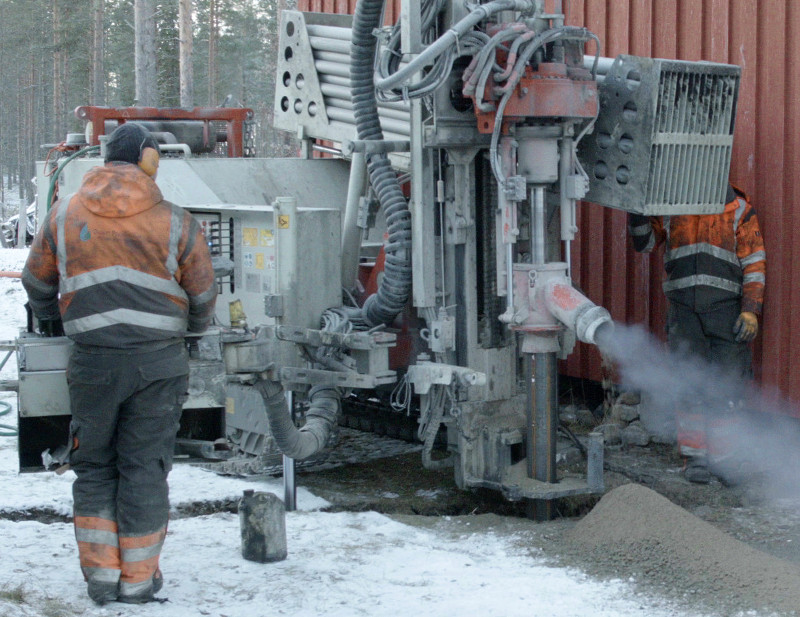
Drilling of a borehole for residential geothermal heating in Northern Finland. Geothermal is an ideal winter heating option because the ground is constantly warm. The rack of tubes is full of drill extenders. Well depths for Massachusetts measure in the hundreds of feet. Public Domain Olli Niemitalo.
A Good Thing for the Planet and Pocketbook
It’s a good thing, for future generations and the planet, that we (i.e., people, collectively) are finally adopting widespread use of these much more efficient machines for warming and cooling. Conventional fossil fuel heating systems range in efficiency from 56% (for older systems) to more than 95% for modern systems. That is to say, a majority of homes in the United States are still heated with systems (gas, oil, coal or propane burning) that waste a percentage of the energy generated by the system.
Heat pumps, on the other hand, deliver more energy (used for heating, cooling and heating water) than the electricity used for their operation. For example, a heat pump system can deliver between 2.5 to 5.5 units of heat for every unit of electricity it consumes. Also, some heat pumps are cheaper to operate than natural gas furnaces (and certainly oil) and can save homeowners $1,000 per year on heating costs.
Heat pump efficiency is usually described using a measurement called “coefficient of performance” (CoP). A CoP of 1 is equivalent to 100% efficiency. Heat pumps typically have CoPs well over 1, with 2.5 to 5.5 CoPs. (It’s not mathematically accurate to say something performs above 100%, but if we were to cheat and use that metric for a moment, we could say heat pumps perform at 250% to 550% efficiency.)
That heightened efficiency allows us to reduce greenhouse gases, such as carbon dioxide, for every system converted away from burning fossil fuels. Greenhouse gases (GHGs) trap heat within our environment, disallowing the earth’s natural cooling when the sun isn’t shining, and gradually contributing to a global cumulative average rise in temperature. The more we can transition away from fossil fuel combustive pollution, the better we can manage the earth’s temperature increase.
About 26% of homes in the U.S. used electricity for all their energy as of 2020, according to the U.S. Energy Information Administration. That statistic has surely risen in subsequent years. Still, a majority of U.S. households continue to burn fossil fuels for their heating, cooling, water heating and cooking energy needs.

Mitsubishi is a popular choice for air source heat pumps in the U.S. Image: CC-BY-SA-4 by Santeri Viinamäki
Three Types of Heat Pumps
There are three kinds of heat pumps: air source (ASHP), water source (WSHP) and ground source (GSHP, also referred to as geothermal). All three serve the same primary purpose: to heat interior spaces during cold weather and cool spaces during warm weather, and to heat water. The difference between the three systems is in how (or from where) they collect and disburse their source energy.
All three types of heat pumps move refrigerant through coils of pipes that interact with surrounding air for the purpose of conditioning it – making it warmer or cooler. But WSHPs and GSHPs also circulate water in different ways to transport and disperse warmth or coolness.
Let’s take a brief detour here to discuss refrigerant.
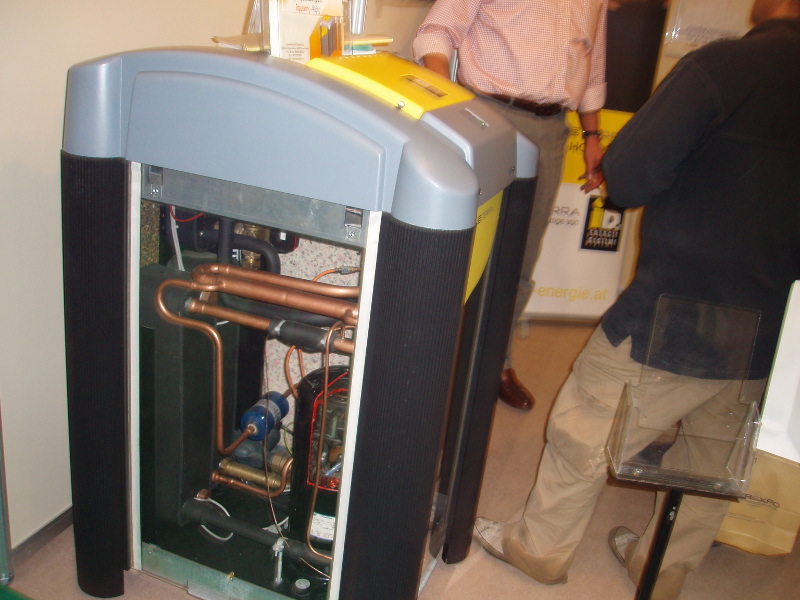
A geothermal heat pump has three components. Antifreeze runs through plastic pipes in the ground (not shown) to collect or deposit heat. Refrigerant runs in copper pipes to pull that heat out of the antifreeze. An air handler (not shown) then heats the premises through ducting. Geothermal heat pumps to baseboard are possible, too, although at time of writing less frequently commercially available. CC BY-SA 4-0 Tzeferis Petros.
What is Refrigerant?
Refrigerants are chemical compounds that can cycle between fluid and gas states. These materials are highly sensitive to changes in pressure and temperature. By alternately squeezing and expanding the refrigerant fluid, we can dramatically increase its ability to emit and absorb heat energy, respectively.
For decades, early refrigerants, which were chlorofluorocarbons (CFCs), heavily contributed to the deterioration of the earth’s ozone layer, and later, as greenhouse gas hydrochlorofluorocarbons (HCFCs), to global warming.
| Emission Type | 20 Year Global Warming Potential (GWP) |
|---|---|
| Carbon Dioxide | 1 |
| Hydrogen | 4.3 |
| Methane Gas | 56 – 96 |
| HFC-134a refrigerant | 3,710 – 3,790 |
| CFC-11 refrigerant | 6,900 – 7,020 |
| HFC-22 (R-22) refrigerant | TBD, 100 year is 1,810 |
| HFC-23 refrigerant | 10,800 – 12,000 |
As shown in the table above, global warming potential (GWP) of some refrigerants, if emitted to the atmosphere, is extremely high, surpassing that of carbon dioxide, hydrogen and even methane.
Refrigerants used today have come a long way. They are mostly hydrofluorocarbonsHFCs) and hydrofluoro-olefins (HFOs), which do not damage the ozone layer. However, these chemicals are GHGs and if released to the atmosphere, do contribute to global warming at various levels. Some HFCs and HFOs are designated environmentally friendly by the Environmental Protection Agency because they do not harm the ozone layer and have relatively lower global warming potential (GWP).
The earliest used refrigerants included dangerous, highly flammable chemicals like ammonia, propane and sulfur dioxide, which frequently resulted in fatal accidents. Hundreds of cycles of refrigerant have been developed over the years since, by Dupont and other chemical companies. Today’s refrigerants have industrial numerical names: R-449a, R-32, R-1234yf, and a common type used in heat pumps, R-410A.
Back to heat pumps.
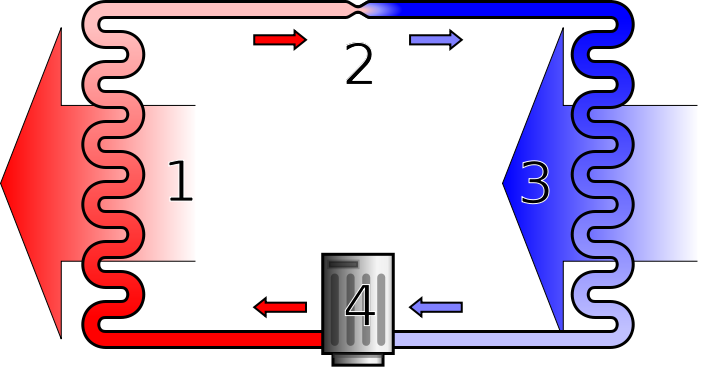
Hot gas refrigerant (1) gives out heat and condenses. It (2) expands and drops temperature by a lot. The very cold liquid refrigerant then (3) takes in heat and boils into a gas. Finally it is (4) compressed to very high temperature and the cycle repeats. Ilmari Karonen released into public domain CC-0.
How Does an Air Source Heat Pump Work?
An ASHP employs a fan to draw in warm or cool air, depending on its seasonal function as either an air heater or cooler. The air interacts with a series of coiled pipes, either warming or cooling the refrigerant that runs through the pipes. The refrigerant is constantly running through the system, from outside to inside to outside, cycling from liquid to gas and back again.
Consider a heating cycle on a cold winter’s day. When the cold outside air meets the exterior unit’s coils, the liquid refrigerant is even colder than the air. It draws heat from that air, which makes the refrigerant boil into gas form.
The boiled refrigerant next moves through a compressor that further increases its temperature and pressure. The very hot gas refrigerant then courses into the interior coils and releases heat to the surrounding interior air, warming the space. When any gas gets cold enough, it condenses into a liquid. The heat pump is designed to make sure this happens. So as the gaseous refrigerant heats the inside, it loses energy, cools and condenses into a liquid. It then goes through an expansion valve, which makes the refrigerant very cold. The liquid then flows back to the exterior unit to repeat the cycle.
Now consider a cooling phase on a hot summer’s day. The heating process is reversed. Outside, the refrigerant is a very hot gas. It dumps heat into the surrounding outdoor air and it condenses. It passes through an expansion valve, which depressurizes the refrigerant and activates a return to very cold liquid form. That cold liquid travels to the inside unit where it absorbs heat from the inside air, resulting in a cooler space. The refrigerant boils as it absorbs heat from inside. The boiled refrigerant is next compressed into a very hot gas. The gas flows back to the outside unit, where it rejects heat, returns to liquid form, and the cycle repeats.
That’s all there is to it. Technicians will use terms like “vaporizer,” “compressor,” “condenser” and “thermal expansion valve.” These just describe particular sections of pipes that we’ve explained above. Those who seek a deeper dive into the details might read more here.
Water Source and Ground Source Heat Pumps
WSHPs and GSHPs work similarly to air source heat pumps, except instead of extracting and dispersing heat from and to surrounding air, these machines use water and/or the ground as their energy source. In fact, you could say that WSHPs and GSHPs are one and the same (both are actually GSHPs) because they both use in-ground sources for absorbing and disbursing heat.
Like ASHPs, WSHPs and GSHPs cycle refrigerant through a system of coiled pipes, compressors and valves. But WSHPs also draw water from a naturally occurring source, such as a nearby well, pond or lake. The water is used to either warm circulating refrigerant or to absorb the heat that refrigerant carries from inside in cooling mode. This type of system is called “open-loop.”
Some GSHPs use a “closed-loop” system, burying the exterior unit of coiled pipes underground and using the earth’s thermal energy to warm circulating fluid or absorb heat carried from inside. At only a few dozen feet deep, the earth’s temperature remains a consistent 45 to 60 degrees Fahrenheit, regardless of fluctuating surface temperatures.
GSHPs are more efficient than ASHPs because the naturally occurring underground temperature is closer to the desired room temperature inside. Therefore, GSHPs require less energy to heat or cool circulating refrigerant.
GSHPs might also be scalable for entire neighborhoods. The city of Framingham is piloting a geothermal system that provides heating and cooling in the Concord Street neighborhood.
Which is Best?
The recent passage of the Inflation Reduction Act makes this a good time to make the transition away from fossil fuel-combusting heating systems and window air conditioners in favor of heat pumps. Tax incentives and rebates are built into the new law that will ease the financial burden for the switch over the next decade.
But as more of us make the eventually inevitable transition, we will have to decide which type of system best fits our needs and resources. Air source heat pumps are the most popular system, for now, for homeowners. They are much cheaper for materials and installation.
But ASHPs are noisy and not as efficient as water source or ground source heat pumps. Their exterior units are also exposed to the weather and therefore may have a shorter lifespan. Then again, WSHPs and GSHPs require more space and typically cost thousands more to install (mostly due to excavation costs). They could also be potentially more expensive to maintain if repairs need to be done underground.
Which system is best is a calculation of interior air-conditioning needs, up-front and long-term costs, and available financial incentives, which may differ depending on your system choice.
Protecting Your Investment
Before long, driveway conversations about our heating and cooling systems will morph from talk about boilers, tanks and filters to air flow, refrigerant and heat exchangers as heat pumps become the standard. Transitioning to a heat pump system is a major project and will come with both short- and long-term expenses.
As with any conventional heating system, general knowledge of how your heat pump system works can save you money on maintenance costs and extend the life of your investment.
Heat Pump FAQ
Do heat pumps generate heat?
No. Heat pumps, unlike fossil fuel-burning furnaces, do not generate heat. They only carry heat that already exists in outside air (or water or underground), via refrigerant, into a space, then release it to warm the space. (In cooling mode, they absorb interior heat, removing it from the space and making it cooler.)
What do you mean heat pumps don’t generate heat? My heat pump killed my shrubs!
Heat pumps don’t produce heat, but they move energy (hot or cold) already in the air. If you place a heat pump near plantings and then run it in “air conditioner mode,” it will move heat from inside your unit onto the shrubs, effectively cooking them. Likewise in winter, a heat pump will extract heat from already cold winter air. If it blows over the shrubs, it will effectively reduce the USDA hardiness zone for that part of your property and freeze your shrubs. Heat pumps need space to breathe and should not be screened or fenced in.
Do heat pumps exchange air?
No. Heat pumps distribute and remove heat that already exists in air. To say they “exchange air” would be to suggest that they trade warm air for cool air, or vice versa, at some point in their process.
Are heat pumps over 100% efficient?
Some media describe heat pumps with phrases like “200% to 500% efficiency” because that metric easily aligns with the metric we use for conventional furnaces, which range from 55% to 95% efficiency. But mathematically, 100% is a maximum and it’s not possible for something to be more than 100% efficient. Heat pumps are described using a metric called CoP, “coefficient of performance.” CoP refers to the amount of energy required to provide the desired result, such as heating and cooling.
Is a heat pump the same as a refrigerator or air conditioner?
Yes. Heat pumps are exactly the same as a refrigerator or air conditioner. They are called "heat pumps" only because they are now available to heat homes in winter, which has historically been the hardest commercial application of refrigerant technology.
Do heat pumps reduce greenhouse gases?
Under normal operation (assuming no leaks), heat pumps entirely eliminate greenhouse gases. The only emissions would be power plant emissions to produce the electricity needed to operate the heat pumps.
Are heat pumps good for a rental property?
Yes. Massachusetts law requires the state to have net zero emissions by 2050. This should put heat pumps on your capital roadmap. Heat pumps are not hard to maintain. They offer renters air conditioning, a desirable amenity. If carefully chosen, they will cost less to operate than gas.
Can I install a heat pump in an old building?
Yes. But first, you should insulate and air seal the building. If you install a heat pump in an uninsulated building, the amount of heat required to keep the building comfortable in the winter will exceed the capacity of a single heat pump. This will require multiple heat pumps, additional install cost and additional operating cost. Insulate first.
I know someone who installed heat pumps in rental property, and they said they would never do it again.
Heat pumps work best in properties that have been insulated and air sealed. Also, they must be chosen carefully to provide the correct heat capacity for the climate. You cannot take recommendations from owners in other parts of the country. Stick with major brands that are well-supported and whose technology is maturing quickly. Also, read the manual before you purchase. Some filters must be cleaned very frequently; others, infrequently. Just like a boiler or a furnace, anything can break over time.


